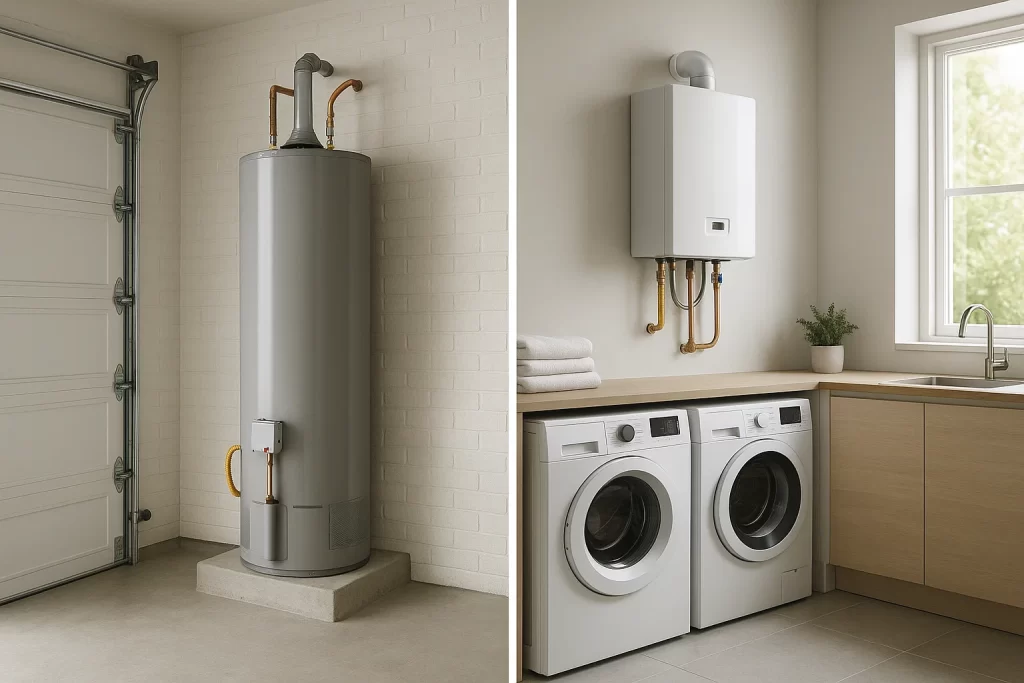When it’s time to install a new water heater or replace your current one, you’ll likely face one big decision: tank or tankless? Both types offer benefits, but the right choice depends on your household size, water usage, energy goals, and budget. Here’s a helpful guide to the pros and cons of each type of system, along with tips on how to determine what’s best for your home and lifestyle.

Understanding the Two Options
Tank Water Heaters
These are the traditional models that store a set amount of hot water (usually 40 to 80 gallons). When hot water is used, the tank refills and heats more water.
Advantages:
- Lower upfront cost
- Simple to install and repair
- Can serve multiple fixtures at once
Drawbacks:
- Limited hot water supply (you can run out)
- Less energy-efficient due to standby heat loss
- Larger footprint, takes up floor space
Tankless Water Heaters
These units heat water only when needed. When you turn on a hot water tap, water passes through heating elements, providing endless hot water without storing it.
Advantages:
- Hot water on demand – no running out
- Energy-efficient, no standby heat loss
- Compact and wall-mounted
- Longer average lifespan (up to 20 years)
Drawbacks:
- Higher upfront cost
- May require system upgrades (gas line or electric panel)
- Might struggle with simultaneous use unless sized correctly
Deciding Between the Two
Key factors to help you choose the best water heater for your home and family:
- Household size and water usage – Smaller households (1–2 people) often benefit from a tankless water heater due to lower demand. Larger families or homes with multiple bathrooms may require a high-capacity tank or more than one tankless unit.
- Energy efficiency – Tankless water heaters are generally more energy-efficient, especially for homes that use less than 41 gallons of hot water per day. High-efficiency tank models are also available and may offer a good compromise between savings and upfront cost.
- Space constraints – Tankless units are perfect for homes with limited space – they mount on the wall and take up minimal room. Tank water heaters need more floor space and may require ventilation if gas-powered.
- Budget and installation costs – Tank models cost less up front and are easier to install – ideal for quick replacements. Tankless systems cost more initially but often pay off in the long run with energy savings and a longer lifespan. Be sure to factor in any upgrades needed for electrical or gas lines if going tankless.
Quick Comparison: Tank vs. Tankless at a Glance
Tank Water Heaters:
- Lower upfront cost
- Easier installation
- May run out of hot water during high use
- Lifespan: 10-15 years
- Takes up more space
Tankless Water Heaters:
- Endless hot water
- Higher energy efficiency
- Higher initial cost
- Lifespan: 15-20 years
- Compact and space-saving
Still Not Sure? Let Us Help
Choosing between a tank or tankless water heater isn’t always simple, but you don’t have to decide alone. Our experienced plumbing team can evaluate your home’s needs, explain your options, and recommend the best solution for your comfort, space, and budget.
Contact Sierra Pacific Home & Comfort, Inc. today to schedule water heater services. You can always trust The Guys in the Big Red Trucks.
